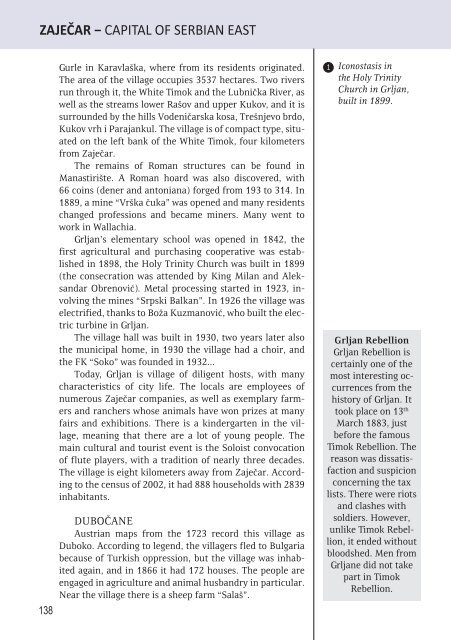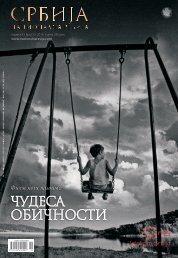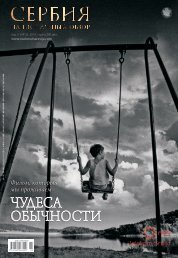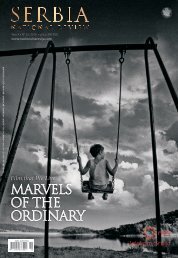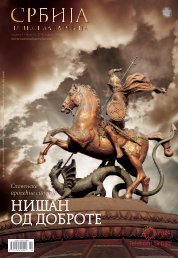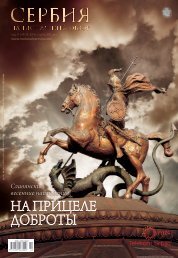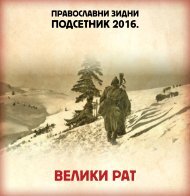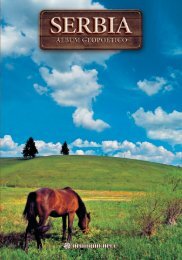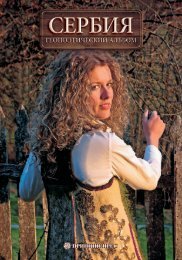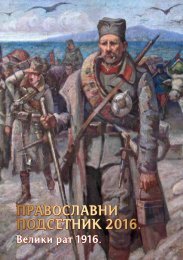Zajecar - engleski - niska rezolucija
You also want an ePaper? Increase the reach of your titles
YUMPU automatically turns print PDFs into web optimized ePapers that Google loves.
ZAJEČAR − CAPITAL OF SERBIAN EAST<br />
Gurle in Karavlaška, where from its residents originated.<br />
The area of the village occupies 3537 hectares. Two rivers<br />
run through it, the White Timok and the Lubnička River, as<br />
well as the streams lower Rašov and upper Kukov, and it is<br />
surrounded by the hills Vodeničarska kosa, Trešnjevo brdo,<br />
Kukov vrh i Parajankul. The village is of compact type, situated<br />
on the left bank of the White Timok, four kilometers<br />
from Zaječar.<br />
The remains of Roman structures can be found in<br />
Manastirište. A Roman hoard was also discovered, with<br />
66 coins (dener and antoniana) forged from 193 to 314. In<br />
1889, a mine “Vrška čuka” was opened and many residents<br />
changed professions and became miners. Many went to<br />
work in Wallachia.<br />
Grljan’s elementary school was opened in 1842, the<br />
first agricultural and purchasing cooperative was established<br />
in 1898, the Holy Trinity Church was built in 1899<br />
(the consecration was attended by King Milan and Aleksandar<br />
Obrenović). Metal processing started in 1923, involving<br />
the mines “Srpski Balkan”. In 1926 the village was<br />
electrified, thanks to Boža Kuzmanović, who built the electric<br />
turbine in Grljan.<br />
The village hall was built in 1930, two years later also<br />
the municipal home, in 1930 the village had a choir, and<br />
the FK “Soko” was founded in 1932...<br />
Today, Grljan is village of diligent hosts, with many<br />
characteristics of city life. The locals are employees of<br />
numerous Zaječar companies, as well as exemplary farmers<br />
and ranchers whose animals have won prizes at many<br />
fairs and exhibitions. There is a kindergarten in the village,<br />
meaning that there are a lot of young people. The<br />
main cultural and tourist event is the Soloist convocation<br />
of flute players, with a tradition of nearly three decades.<br />
The village is eight kilometers away from Zaječar. According<br />
to the census of 2002, it had 888 households with 2839<br />
inhabitants.<br />
DUBOČANE<br />
Austrian maps from the 1723 record this village as<br />
Duboko. According to legend, the villagers fled to Bulgaria<br />
because of Turkish oppression, but the village was inhabited<br />
again, and in 1866 it had 172 houses. The people are<br />
engaged in agriculture and animal husbandry in particular.<br />
Near the village there is a sheep farm “Salaš”.<br />
138<br />
1<br />
Iconostasis in<br />
the Holy Trinity<br />
Church in Gr lja n,<br />
built in 1899.<br />
Gr ljan Rebellion<br />
Grljan Rebellion is<br />
certainly one of the<br />
most interesting occurrences<br />
from the<br />
history of Grljan. It<br />
took place on 13 th<br />
March 1883, just<br />
before the famous<br />
Timok Rebellion. The<br />
reason was dissatisfaction<br />
and suspicion<br />
concerning the tax<br />
lists. There were riots<br />
and clashes with<br />
soldiers. However,<br />
unlike Timok Rebellion,<br />
it ended without<br />
bloodshed. Men from<br />
Grljane did not take<br />
part in Timok<br />
Rebellion.


